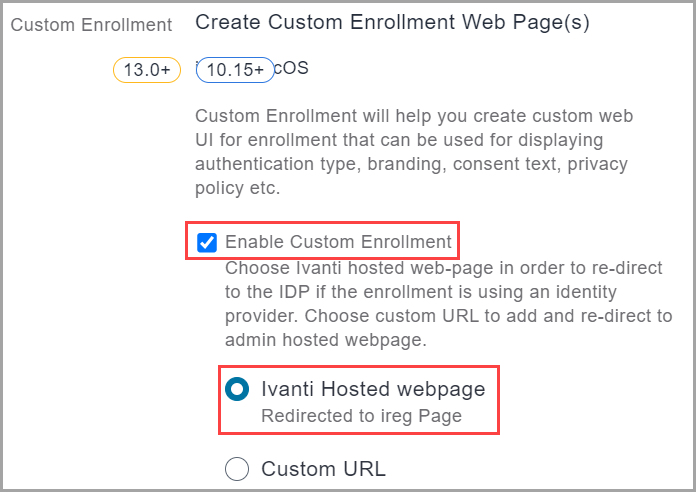Configure Identity Provider
License:Silver
Configure an identity provider (IdP) to authenticate users who wish to register devices with Ivanti Neurons for MDM, access this Admin Portal, or access the Self-Service Portal. An on-prem LDAP compatible user directory is required. Ivanti Neurons for MDM works with any SAML 2.0 compatible IdP. Microsoft Azure AD Authentication (Azure AD), Microsoft ADFS (Active Directory Federation Services), Okta, OneLogin, PingOne, and Ping Identity's PingFederate have been verified to work with Ivanti Neurons for MDM.
Previously, if you setup SAML auth/IdP, SAML authentication is used for both device registration and portal authentication. Now, a toggle button is provisioned to choose different authentication methods for Admin Portal access and Device Registration. The bypass toggle is applicable only for device registration.
During device registration, the administrator can bypass the identity provider option and provide the user with the option to authenticate using a PIN instead of authentication using the identity provider page.
Overview
-
If you are using Microsoft AD, or another on-premise LDAP directory, you will need to set up Connector to connect to and import users to Ivanti Neurons for MDM. Set up Connector or LDAP if you have not done so already.
-
When an IdP is added, user authentication automatically switches from LDAP to IdP.
-
Only one IdP provider is allowed.
-
In case your IdP becomes inaccessible, use the Ivanti Neurons for MDM Tenant Admin (TA) account to access this Admin Portal and troubleshoot. The TA is a Local account and does not require external authentication. The TA account is created when your Ivanti Neurons for MDM is provisioned and information provided to the technical contact of your organization, or equivalent. If you do not have your TA account information, contact your support representative.
-
Ivanti Neurons for MDM supports Microsoft Azure Active Directory (Azure AD) for authenticating users during registration of Windows 10 devices.
Set the authentication type for your LDAP users using the tools provided by your IdP vendor. The authentication scheme of your IdP will take precedence over the Ivanti Neurons for MDM settings.Ivanti Neurons for MDM Authentication settings can be found here: Users > User Settings > Device Registration Setting > Device Registration Authentication Type.
-
Apple Device Enrollment and Configurator device enrollments do not use IdP for user Authentication.
-
To configure an identity provider to work for registering Apple Business Manager iOS and macOS devices, you must enable the Enable Custom Enrollment and the related Ivanti Hosted webpage settings found at Admin > Apple > Device Enrollment > edit a device enrollment profile. See Device Enrollment for more information:

IdP Set Up Types
The Ivanti Neurons for MDM Identity page guides you through the set up of the following types of IdP providers:
- Ivanti Neurons for MDM IdP Setup- Supported Ivanti Neurons for MDM IdP providers are Azure AD, OneLogin, Okta, and PingOne.
- On-Prem IdP Setup- Supported on-prem IdP providers are ADFS 3.0, PingFederate 8.2.1, and PingFederate 8.1.3.
- Generic IdP Setup- This is a generic set up path you can use if you are not using Microsoft ADFS, Okta, OneLogin, or PingFederate.
Configuring an identity provider (IdP)
Procedure
- Go to Admin > Identity > SAML Authentication.
- Click an identity provider set up type:
- Ivanti Neurons for MDM IDP Setup
- On-Prem IDP Setup
- Generic IDP Setup
- Select a corresponding IdP. If you selected Generic IDP Setup in step 3, then skip this step and continue from step 5.
- Follow the instructions on the screen that appear for your chosen IdP.
- Click Done.
Administrators are allowed to single sign-on for up to 2 hours from their initial authentication with the IdP.
Setting up tasks you may need to complete
Depending on your chosen IdP, you will be guided through the following associated pages and steps:
| IdP | Procedure |
|---|---|
|
|
|
|
|
|
Enabling local users to bypass IdP authentication
When an IdP or Ivanti Neurons for MDM connectivity goes down and needs troubleshooting from the Ivanti Neurons for MDM side, certain administrators need the ability to login to Ivanti Neurons for MDM without reliance on external systems, such as, LDAP or IdP, for authentication. Only local users with system admin roles can bypass IdP authentication.
Create a list of local users to bypass IdP authentication.
Procedure
- Click Admin > Identity.
- Under the Local Users to Bypass IdP Authentication section, click +Add Users.
- From the list displaying only the local users with system admin roles, select a few users.
- Click Save.
To remove a user from the list of local users that bypass IdP authentication, click the remove icon next to the entry you want to delete.
If you cannot see the Identity page, it might be that you do not have the required permissions. You need one of the following roles:
-
System Management
-
System Read Only